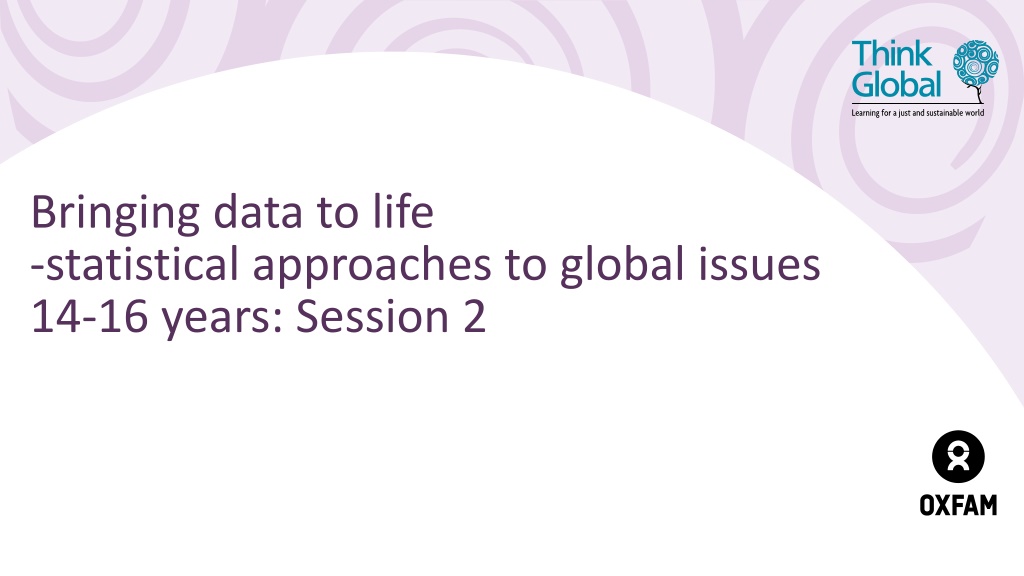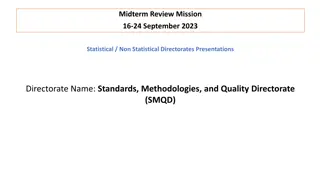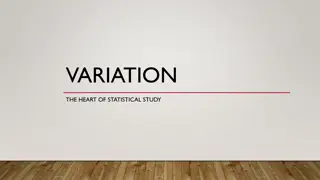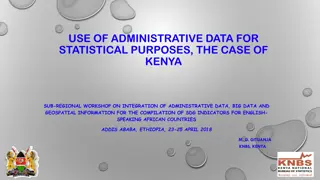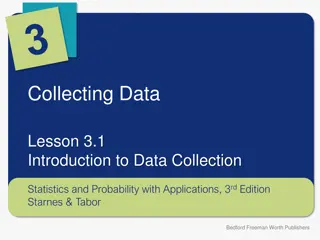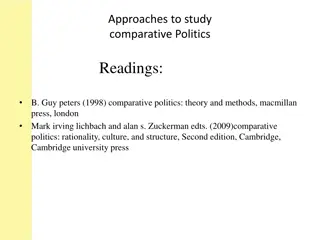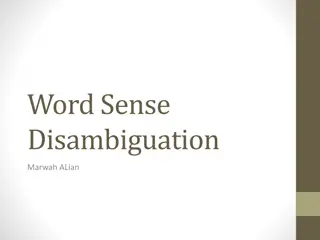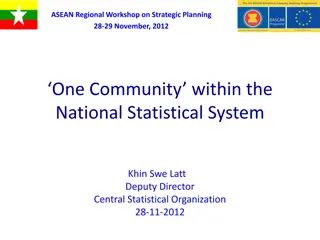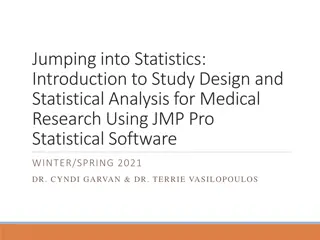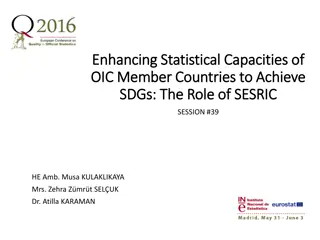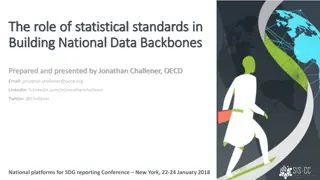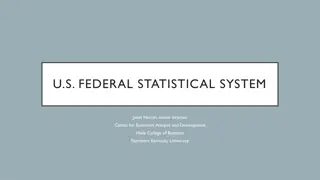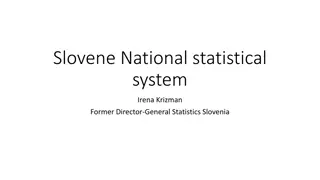Statistical Approaches to Global Issues
This session delves into statistical approaches for understanding global issues affecting women's collective action, particularly in Mali and Ethiopia. Explore cumulative frequency graphs and tables reflecting wealth index data, shedding light on living standards and empowerment initiatives.
Download Presentation

Please find below an Image/Link to download the presentation.
The content on the website is provided AS IS for your information and personal use only. It may not be sold, licensed, or shared on other websites without obtaining consent from the author.If you encounter any issues during the download, it is possible that the publisher has removed the file from their server.
You are allowed to download the files provided on this website for personal or commercial use, subject to the condition that they are used lawfully. All files are the property of their respective owners.
The content on the website is provided AS IS for your information and personal use only. It may not be sold, licensed, or shared on other websites without obtaining consent from the author.
E N D
Presentation Transcript
Bringing data to life -statistical approaches to global issues 14-16 years: Session 2
Cumulative Frequency Graphs
Shea butter production -Mali Insert map of Mali
Cumulative Frequency This table shows the wealth index of 295 WCA group members in Ethiopia. Wealth Index 0 ? < 10 10 ? < 20 20 ? < 30 30 ? < 40 40 ? < 50 50 ? < 60 60 ? < 70 70 ? < 80 80 ? < 90 90 ? < 100 100 ? < 110 Frequency 3 25 69 87 61 28 12 4 5 0 1 The wealth index is a measure of a household's living standard. The wealth index is calculated using data on a household's possessions, livestock and housing characteristics, such as whether they have a grass or tin roof.
Cumulative Frequency This table shows the wealth index of 295 WCA group members in Ethiopia. Wealth Index 0 ? < 10 10 ? < 20 20 ? < 30 30 ? < 40 40 ? < 50 50 ? < 60 60 ? < 70 70 ? < 80 80 ? < 90 90 ? < 100 100 ? < 110 Frequency 3 25 69 87 61 28 12 4 5 0 1 The cumulative frequency is obtained by adding up the frequencies as you go along, to give a 'running total'. You should notice a difference in the class intervals.
Cumulative Frequency This table shows the wealth index of 295 WCA group members in Ethiopia. Wealth Index Frequency Wealth Index 0 ? < 10 10 ? < 20 20 ? < 30 30 ? < 40 40 ? < 50 50 ? < 60 60 ? < 70 70 ? < 80 80 ? < 90 90 ? < 100 100 ? < 110 Frequency 3 25 69 87 61 28 12 4 5 0 1 0 ? < 10 0 ? < 20 0 ? < 30 0 ? < 40 0 ? < 50 0 ? < 60 0 ? < 70 0 ? < 80 0 ? < 90 0 ? < 100 0 ? < 110
Cumulative Frequency This table shows the wealth index of 295 WCA group members in Ethiopia. Wealth Index Frequency 3 Wealth Index Frequency 3 25 69 87 61 28 12 4 5 0 1 0 ? < 10 0 ? < 10 0 ? < 20 10 ? < 20 20 ? < 30 0 ? < 30 30 ? < 40 0 ? < 40 40 ? < 50 0 ? < 50 50 ? < 60 0 ? < 60 60 ? < 70 0 ? < 70 70 ? < 80 0 ? < 80 80 ? < 90 0 ? < 90 90 ? < 100 0 ? < 100 100 ? < 110 0 ? < 110
Cumulative Frequency This table shows the wealth index of 295 WCA group members in Ethiopia. Wealth Index Frequency 3 28 Wealth Index Frequency 3 25 69 87 61 28 12 4 5 0 1 0 ? < 10 0 ? < 10 0 ? < 20 10 ? < 20 20 ? < 30 0 ? < 30 30 ? < 40 0 ? < 40 40 ? < 50 0 ? < 50 50 ? < 60 0 ? < 60 60 ? < 70 0 ? < 70 70 ? < 80 0 ? < 80 80 ? < 90 0 ? < 90 90 ? < 100 0 ? < 100 100 ? < 110 0 ? < 110
Cumulative Frequency This table shows the wealth index of 295 WCA group members in Ethiopia. Wealth Index Frequency 3 25 69 87 61 28 12 4 5 0 1 Wealth Index Frequency 3 28 97 184 245 273 285 289 294 294 295 0 ? < 10 0 ? < 10 10 ? < 20 0 ? < 20 20 ? < 30 0 ? < 30 30 ? < 40 0 ? < 40 40 ? < 50 0 ? < 50 50 ? < 60 0 ? < 60 60 ? < 70 0 ? < 70 70 ? < 80 0 ? < 80 80 ? < 90 0 ? < 90 90 ? < 100 0 ? < 100 100 ? < 110 0 ? < 110
Cumulative Frequency graph to show the wealth index of 295 WCA group members in Ethiopia. Cumulative Frequency Wealth Index
Cumulative Frequency An average allows us to summarise and compare data. From the graph, we can easily work out the median value. Median = The value of the middle piece of data when ordered. To find the position of the middle piece of data: ? 2 where ? is how many pieces of data you have.
Cumulative Frequency Median = The value of the middle piece of data when ordered. Since here we are looking at 295 pieces of data 295 2= 147.5 Use your graph to read across at this value. At the curve, draw a perpendicular line down to the x-axis to find the median.
Cumulative Frequency graph to show the wealth index of 295 WCA group members in Ethiopia. Cumulative Frequency 35 Wealth Index
Cumulative Frequency This table shows the wealth index of 295 WCA group members in Ethiopia. Wealth Index Frequency 3 25 69 87 61 28 12 4 5 0 1 Look at the original data. An average of 35 seems sensible. 0 ? < 10 10 ? < 20 20 ? < 30 30 ? < 40 40 ? < 50 50 ? < 60 60 ? < 70 70 ? < 80 80 ? < 90 90 ? < 100 100 ? < 110
Cumulative Frequency This table shows the wealth index of 295 WCA group members in Ethiopia. Wealth Index Frequency 3 25 69 87 61 28 12 4 5 0 1 Quartiles Quartiles divide the data into four sections. This allows us to consider the middle 50% of the data and factors out any outliers that might be in the top 25% or the bottom 25%. 0 ? < 10 10 ? < 20 20 ? < 30 30 ? < 40 40 ? < 50 50 ? < 60 60 ? < 70 70 ? < 80 80 ? < 90 90 ? < 100 100 ? < 110
Cumulative Frequency We want to split the data into four sections. 25% 25% 25% 25% Median Upper Quartile Lower Quartile To find the position of the lower quartile: ? 4 where ? is how many pieces of data you have.
Cumulative Frequency Since here we are looking at 295 pieces of data 295 4= 73.75
Cumulative Frequency We want to split the data into four sections. 25% 25% 25% 25% Median Upper Quartile Lower Quartile 73.75th piece of data 147.5th piece of data 221.25th piece of data To get this number, we added 73.75 to 147.5 to find out the position of the piece of data that was three quarters of the way through. (You could also multiply 73.75 by three).
Cumulative Frequency graph to show the wealth index of 295 WCA group members in Ethiopia. 221.25 Cumulative Frequency Upper Quartile = 46 Median = 35 Lower Quartile = 26 Interquartile range = 20 147.5 73.75 46 26 35 Wealth Index
Cumulative Frequency What does this mean for honey producers who are members of the Women s Collective Action group in Ethiopia? The average wealth index is 35. Half of the women asked are wealthier than this, and half are less wealthy. Upper Quartile = 46 Median = 35 Lower Quartile = 26 Interquartile range = 20 50% of the women have a wealth index of between 26 and 46 the data before 26 and beyond 46 may include outliers.
Cumulative Frequency Use the data on the learner worksheet B to create your own cumulative frequency graph. 1. Step 1: Add up the frequencies as you go along to create a running total . 2. Step 2: Plot the data at the top of the class interval. 3. Step 3: Join the points up with a smooth curve.
Cumulative Frequency This table shows the wealth index of 571 non-WCA group members in Ethiopia this information is on page two of your learner worksheet . Wealth Index Frequency 4 27 131 198 138 46 22 5 Wealth Index Frequency 0 ? < 10 0 ? < 10 10 ? < 20 0 ? < 20 20 ? < 30 0 ? < 30 30 ? < 40 0 ? < 40 40 ? < 50 0 ? < 50 50 ? < 60 0 ? < 60 60 ? < 70 0 ? < 70 70 ? < 80 0 ? < 80
Cumulative Frequency graph to show the wealth index of the 571 non-WCA group members in Ethiopia. Cumulative Frequency 35 Wealth Index
Cumulative Frequency Generally your median and quartile values may vary as you are reading from a graph. In an exam question, you would be given a small range of correct answers.
Comparing two sets of data WCA Members - Ethiopia Non-WCA Members - Ethiopia 26 35 46 20 Lower Quartile Lower Quartile Median Median Upper Quartile Upper Quartile IQR IQR When comparing data from a cumulative frequency graph, we tend to focus on the median and the interquartile range. This means the person reading your conclusions knows the average for each and also how spread out the data is. If the IQR is small, that means the data is closer together and therefore more consistent. If the IQR is large, that means the data is more spread out and therefore less consistent.
Questions to consider What did you notice about how many people were surveyed? What difference might this have made? Is it financially beneficial to be a member of a WCA in Mali or Ethiopia? The data in the table is grouped together into categories or class intervals - what are the advantages and disadvantages of this? Did being a member of the WCA make the wealth of the women more or less consistent? These graphs only look at the impact the WCA has on wealth. What other benefits do you think the WCA has on the women of Ethiopia and Mali?
